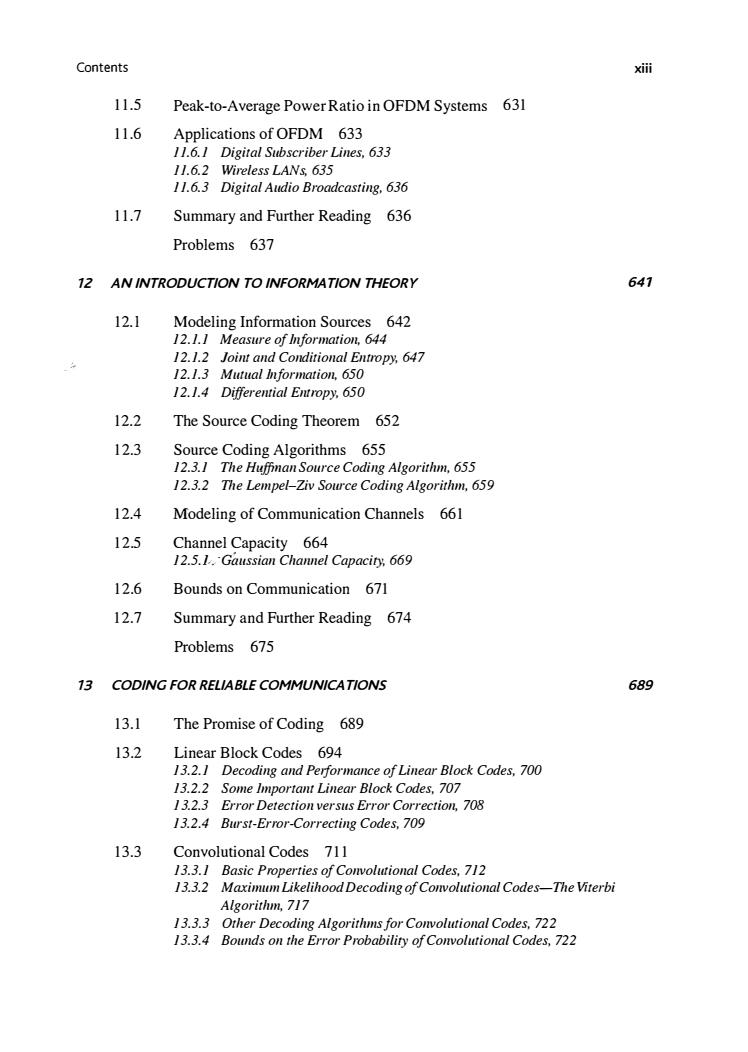正在加载图片...

Contents xiii 11.5 Peak-to-Average Power Ratio in OFDM Systems 631 11.6 Applications of OFDM 633 11.6.1 Digital Subscriber Lines,633 11.6.2 Wireless LANs,635 11.6.3 Digital Audio Broadcasting,636 11.7 Summary and Further Reading 636 Problems 637 12 AN INTRODUCTION TO INFORMATION THEORY 647 12.1 Modeling Information Sources 642 12.1.1 Measure of Information,644 12.1.2 Joint and Conditional Entropy,647 12.1.3 Mutual Information,650 12.1.4 Differential Entropy,650 12.2 The Source Coding Theorem 652 12.3 Source Coding Algorithms 655 12.3.1 The Huffinan Source Coding Algorithm,655 12.3.2 The Lempel-Ziv Source Coding Algorithm,659 12.4 Modeling of Communication Channels 661 12.5 Channel Capacity 664 12.5.1.Gaussian Channel Capaciry,669 12.6 Bounds on Communication 671 12.7 Summary and Further Reading 674 Problems 675 13 CODING FOR RELIABLE COMMUNICATIONS 689 13.1 The Promise of Coding 689 13.2 Linear Block Codes 694 13.2.1 Decoding and Performance of Linear Block Codes,700 13.2.2 Some Important Linear Block Codes,707 13.2.3 Error Detection versus Error Correction,708 13.2.4 Burst-Error-Correcting Codes,709 13.3 Convolutional Codes 711 13.3.1 Basic Properties of Convolutional Codes,712 13.3.2 Maximum Likelihood Decoding of Convolutional Codes-The Viterbi Algorithm,717 13.3.3 Other Decoding Algorithms for Convolutional Codes,722 13.3.4 Bounds on the Error Probabiliry of Convolutional Codes,722Contents 11.5 Peak-to-Average Power Ratio in OFDM Systems 631 11.6 Applications of OFDM 633 I I.6.I Digital Subscriber Lines, 633 I I.6.2 Wireless LANs, 635 I I.6.3 Digital Audio Broadcasting, 636 11. 7 Summary and Further Reading 636 Problems 637 12 AN INTRODUCTION TO INFORMATION THEORY 12. l Modeling Information Sources 642 12.I.1 Measure of Information, 644 12.1.2 Joint and Conditional Entropy, 647 12.I.3 Mutual Information, 650 12.1.4 Differential Entropy, 650 12.2 The Source Coding Theorem 652 12.3 Source Coding Algorithms 655 12.3.1 The Huffman Source Coding Algorithm, 655 12.3.2 The Lempel-Ziv Source Coding Algorithm, 659 12.4 Modeling of Communication Channels 661 12.5 Channel Capacity 664 12.5. J,. ·Gaussian Channel Capacity, 669 12.6 Bounds on Communication 671 12.7 Summary and Further Reading 674 Problems 675 13 CODING FOR RELIABLE COMMUNICATIONS 13. 1 The Promise of Coding 689 13.2 Linear Block Codes 694 13.2.1 Decoding and Performance of Linear Block Codes, 700 I3.2.2 Some Important Linear Block Codes, 707 I 3.2.3 Error Detection versus Error Correction, 708 13.2.4 Burst-Error-Correcting Codes, 709 13.3 Convolutional Codes 711 I 3.3.1 Basic Properties of Convolutional Codes, 712 13.3.2 Maximum Likelihood Decoding ofConvolutional Codes-The Viterbi Algorithm, 717 13.3.3 Other Decoding Algorithms for Convolutional Codes, 722 13.3.4 Bounds on the Error Probability of Convolutional Codes, 722 xiii 647 689